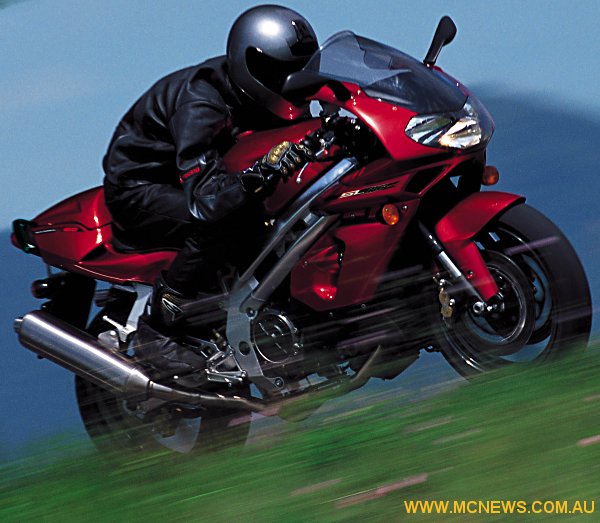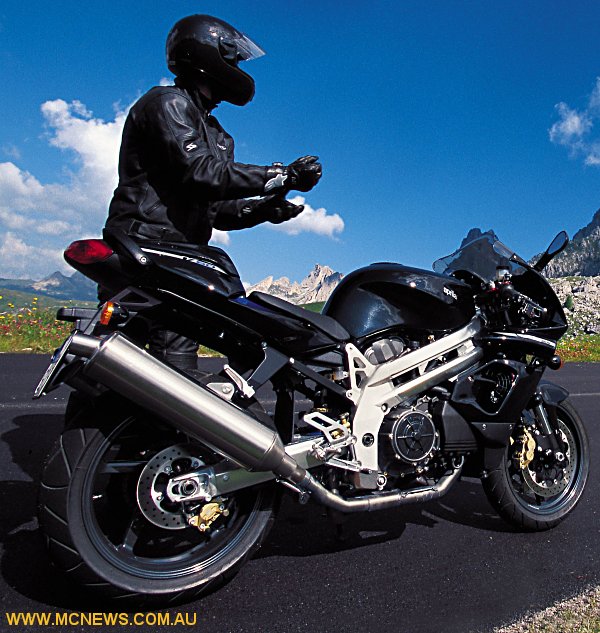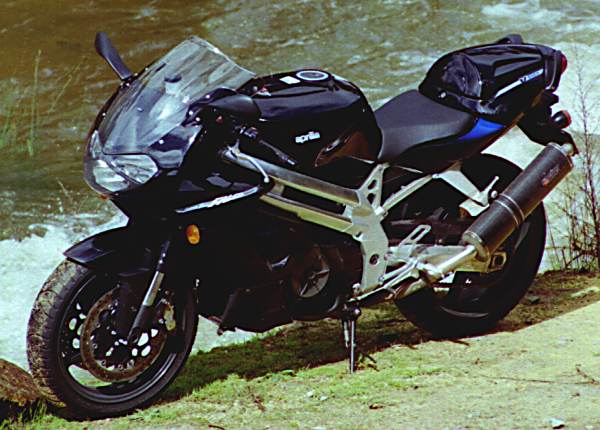The Falco is the slightly softer cousin of the more sports oriented RSV Mille and serves as Aprilia’s first foray in to the highly competitive V-Twin Sport-Touring market.
The 998cc engine revs very quickly and is extremely strong in the lower rpm ranges. But unlike many twin cylinder engines which share that trait at the expense of outright performance the Falco charges on with an extremely progressive curve of power all the way through to around 10,500rpm before smacking the limiter.
These dyno charts show the Falco pitted against the Ducati ST2 and ST4. On the left is the power chart and on the right is the torque chart. Click the thumb nailed images to open the full charts in a new window.
Shifting the cogs is a pretty smooth affair thanks to a good 6-speed gearbox that features very short gearing in the lower gears. This makes the bike great around town. However much restraint is required when leaving the lights as the front wheel rockets skywards under any slightly urgent use of the throttle.
The dash is quite well designed with a conventional tacho’ in the centre which is flanked by digital displays on either side which contain the speedo, tripmeter, odometer, clock, recorded average speed, recorded top speed and temperature gauges. The fact that there is no fuel gauge is a particularly annoying oversight. A fuel warning light comes on after around 180 kilometres to let you know that around 5 litres remains in the tank which should get you at least a further 60 kilometres before grinding to a halt. On a 110kph@4000rpm highway crawl I would think that the 21-litre tank may well stretch to nearly 300 kilometres.

In the comfort stakes the Aprilia acquits itself very well indeed. After a couple of 300 kilometre stints my muscles showed no hints of soreness. The excellent screen looks too small to be effective but I can assure you that it works very well indeed. I can’t work out why it is so effective but Aprilia do spend plenty of time in the wind tunnel so maybe excellence in design is the reason. The comfortable riding position is not too upright, which makes it easy for you to move around on the bike when traversing your favourite stretch of bends. The Falco is more comfortable than a Suzuki TL1000S, Ducati ST, Honda Firestorm or BMW R1100S.
A serious track day punter would consider upgrading the rear shock but I have no doubt that if pitted against any of the V-Twin Sports-Tourers the Falco would prove quickest at the track. The brakes have excellent strength with a great deal of feel that makes stopping an effortless affair.

I covered plenty of different road conditions during the test including bumpy corners, smooth bends, lots of shitty road-works and long straight stretches to test the comfort level. The Falco absorbed it all in it’s stride and did not put a foot (wheel) wrong.
An optional freer flowing (and magnificent sounding) exhaust system is available from Aprilia for $1,640 and comes complete with injection mapping to suit the new pipes.
Another option that is well worth considering should you be planning any extended touring are the soft panniers for $640. For an extra $170 you can also get the matching top-bag. The tank does not accept a magnetic tankbag but Aprilia can supply a tankbag to suit for $275.
I honestly did not expect the Falco to be as good as it proved to be. At just under $20,000 on the road the Aprilia is around $4,500 more expensive than the Honda Firestorm or Suzuki TL1000S and nearly even money with the Ducati ST4.
The Falco has a finely balanced chassis with excellent suspension and a decent tank range. In my mind the Aprilia is clearly the leader of this class and my time on the bike proved it to be a very comfortable, practical and downright fun bike in all situations.
Specifications
Engine – two-cylinder, longitudinal V 60°, 4-stroke, anti vibration double countershaft AVDC
Cooling – liquid cooled, with three-way-pressurized circuit, double radiator, circuit capacity l 2.6
Bore and stroke – 97 x 67,5 mm
Displacement – 997,62 cc
Compression ratio – 10,8:1
Valve actuation – double overhead camshaft operated by a mixed gear/chain system, 4 valves per cylinder
Measured rear wheel horsepower – 104hp
Measured rear wheel torque – 91.2Nm
Induction – integrated system for electronic engine management. Indirect multipoint injection, 51mm throttle bodies
Ignition – electronic digital with two sparks for cylinder, integrated with injection
Starting – electric
Lubrication – Dry sump with separate oil tank. Double trochoidal pump with oil cooling radiator.
Gearbox – 6 speed
Clutch – multiple discs in oil bath with servo-assisted hydraulic control Pneumatic Power Clutch
Frame – Aluminium/magnesium alloy double twin beam. Saddle frame dismountable in aluminium alloy;
Max length – 2050 mm
Max width – 736 mm (at semi-handlebar)
Max height – 1210 mm (at dashboard)
Saddle height – 815 mm (max extension)
Handlebar height – 888 mm external points
Wheelbase – 1415 mm
Trail – 100 mm
Castor angle – 24.5°
Front suspension – upside-down Showa fork, legs Ø 43 mm, travel 120 mm, external adjustment system for hydraulics in rebound, compression and preload
Rear suspension – swingarm in aluminium alloy; progressive link with APS system Sachs hydraulic shock-absorber adjustable in extension and preload. Travel 130 mm.
Front brake – Brembo double floating stainless steel discs Ø 320 mm, caliper with 4 differentiated diameter pistons Ø 34 mm and 30 mm. Brake pads in sintered material. Freudenberg brake tubes
Rear brake – stainless steel disc Ø 220 mm, caliper with 2 pistons Ø 32 mm. Freudenberg brake tubes
Rims – Brembo in aluminium alloy, 5 spokes, front: 3,50 X 17″ , rear: 6,00 X 17″
Tyres – radial tubeless; front: 120/70 ZR 17 , rear: 180/55 ZR 17
Dry weight – 190 Kg, front 49%, rear 51%
Tank capacity – 21 litres, reserve 4 litres
























